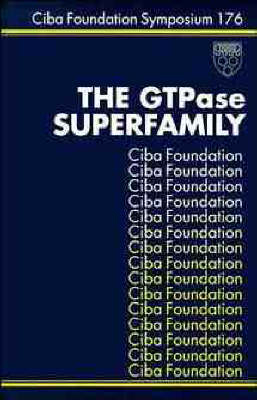
The GTPase Superfamily
Seiten
1993
John Wiley & Sons Ltd (Verlag)
978-0-471-93914-6 (ISBN)
John Wiley & Sons Ltd (Verlag)
978-0-471-93914-6 (ISBN)
- Titel ist leider vergriffen;
keine Neuauflage - Artikel merken
This volume contains the proceedings of an international symposium which discussed the many members of the GTPase superfamily, with emphasis on their common property of developing increased affinity for a target when bound to GTP, and losing that affinity when GTP is hydrolysed.
The GTPase Superfamily Chairman: Frank McCormick 1993 GTPases are enzymes that use GTP hydrolysis to drive the sequential binding of molecules to a series of reaction partners. They play important roles in ribosomal protein synthesis, translocation of nascent proteins into the endoplasmic reticulum, transmembrane signalling by hormones and light, the control of differentiation and cell proliferation, and the targeting of vesicular traffic within cells. GTPase activity is also associated with two of the mechanochemical enzymes, dynamin and tubulin, that generate force for intracellular movement. Although GTPases fulfil such diverse functions, they are related by the possession of distinct, highly conserved sequence motifs that encode the guanine nucleotide-binding domain. Rapid advances in determining the crystal structures of some of the superfamily members have shed light on the nature of this region, which allows the protein to act as a molecular switch. This switch mechanism, turned on' by the binding of GTP and off' by the hydrolysis of GTP to GDP, appears to have arisen early in evolution and has since been adapted to suit a variety of functions in the cell.
If the GTPase switch is damaged, or locked on' then a number of diseases, including cancers, can arise. The effector proteins with which GTPases interact and their downstream target molecules are now being identified: this book contains recent information on these and discussion of their importance in different cellular functions. The various regulatory proteins that modulate GTPase activity are also described by some of the leading biochemists, geneticists and cell and molecular biologists from this field. Other recent Ciba Foundation Symposia: No. 164 Interactions among cell signalling systems Chairman: Y. Nishizuka 1992 ISBN 0 471 93073 3 No. 167 Polyfunctional cytokines: IL-6 and LIF Chairman: D. Metcalf 1992 ISBN 0 471 93439 9 No. 170 Regulation of the eukaryotic cell cycle Chairman: T. Hunter 1992 ISBN 0 471 93446 1
The GTPase Superfamily Chairman: Frank McCormick 1993 GTPases are enzymes that use GTP hydrolysis to drive the sequential binding of molecules to a series of reaction partners. They play important roles in ribosomal protein synthesis, translocation of nascent proteins into the endoplasmic reticulum, transmembrane signalling by hormones and light, the control of differentiation and cell proliferation, and the targeting of vesicular traffic within cells. GTPase activity is also associated with two of the mechanochemical enzymes, dynamin and tubulin, that generate force for intracellular movement. Although GTPases fulfil such diverse functions, they are related by the possession of distinct, highly conserved sequence motifs that encode the guanine nucleotide-binding domain. Rapid advances in determining the crystal structures of some of the superfamily members have shed light on the nature of this region, which allows the protein to act as a molecular switch. This switch mechanism, turned on' by the binding of GTP and off' by the hydrolysis of GTP to GDP, appears to have arisen early in evolution and has since been adapted to suit a variety of functions in the cell.
If the GTPase switch is damaged, or locked on' then a number of diseases, including cancers, can arise. The effector proteins with which GTPases interact and their downstream target molecules are now being identified: this book contains recent information on these and discussion of their importance in different cellular functions. The various regulatory proteins that modulate GTPase activity are also described by some of the leading biochemists, geneticists and cell and molecular biologists from this field. Other recent Ciba Foundation Symposia: No. 164 Interactions among cell signalling systems Chairman: Y. Nishizuka 1992 ISBN 0 471 93073 3 No. 167 Polyfunctional cytokines: IL-6 and LIF Chairman: D. Metcalf 1992 ISBN 0 471 93439 9 No. 170 Regulation of the eukaryotic cell cycle Chairman: T. Hunter 1992 ISBN 0 471 93446 1
Partial table of contents:; Elongation Factors in Protein Synthesis (B. Kraal, et al.); Identification of ras Targets Using a Genetic Approach (U. Gaul, et al.); Regulators of Small GTPases (Y. Takai, et al.); Dynamin, a GTPase Involved in the Initial Stages of Endocytosis (R. Vallee, et al.); Mx Proteins: GTPases Involved in the Interferon-Induced Antiviral State (J. Pavlovic, et al.); Should the Tubulins Be Members of the GTPase Superfamily?; (R. Burns, et al.); Indexes.
| Erscheint lt. Verlag | 5.8.1993 |
|---|---|
| Reihe/Serie | Ciba Foundation Symposium ; No. 176 |
| Verlagsort | Chichester |
| Sprache | englisch |
| Maße | 156 x 235 mm |
| Gewicht | 580 g |
| Themenwelt | Naturwissenschaften ► Biologie ► Biochemie |
| Naturwissenschaften ► Biologie ► Zellbiologie | |
| ISBN-10 | 0-471-93914-5 / 0471939145 |
| ISBN-13 | 978-0-471-93914-6 / 9780471939146 |
| Zustand | Neuware |
| Haben Sie eine Frage zum Produkt? |
Mehr entdecken
aus dem Bereich
aus dem Bereich


